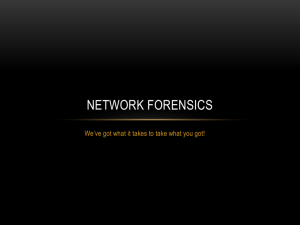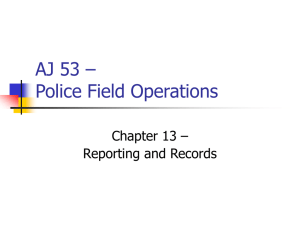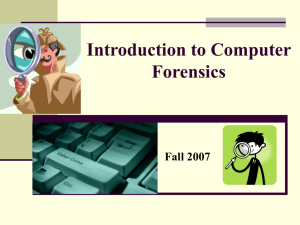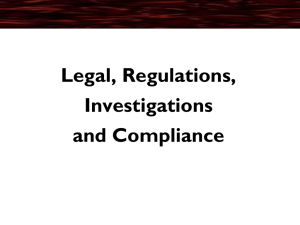15. Legal, Regulations, Compliance, and Investigations
advertisement
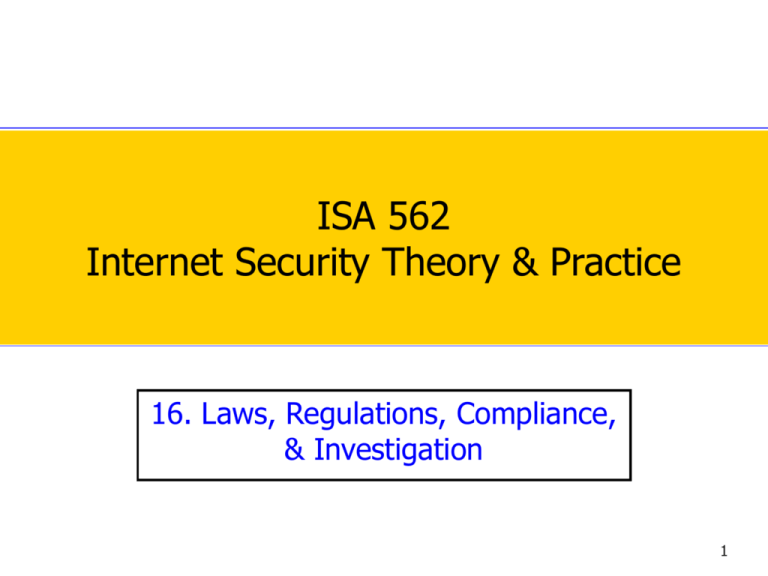
ISA 562 Internet Security Theory & Practice 16. Laws, Regulations, Compliance, & Investigation 1 Objectives Computer crime Laws and regulations for IT Differences and similarities between common and Civil law Incident response technology Forensics Etc. 2 Introduction Need to decide on a suitable set of investigative procedures (involving techniques and measures) used to determine if a crime has been committed Provide methods to gather and secure evidence (chain of evidence) Develop incident-handling capabilities to react quickly and efficiently to malicious threats or suspicious incidents 3 Major Legal Systems Common Law English roots originally developed from court decisions based on customs, traditions and precedents. Law types: Criminal Law Torts Administrative Law 4 Legal Systems Civil Law Custom Society's norms and values Religious Law Roots back to Roman empire and Napoleonic Code of France Body of laws established by state or nation for its own regulations Examples: Islamic Mosaic, etc. Mixed Law Combining legal systems Important in inter-state or international crime! 5 IT Laws and regulations Intellectual property designed to protect intangible items, and property from those wishing to copy or use it without compensation to the inventor or creator: Patent: an invention registered with the relevant office Copyright: an expression in tangible media Trademark: a symbol representing a product (to identify goods and distinguish them from those of others) Trade secret: valuable business or technical information, processes, etc that are confidential and critical to business Software License of copyrighted material Freeware, Shareware, Commercial, Academic 6 IT Laws (continued) Privacy: rights and obligations of individuals and organizations over personal material Initiatives Generic approaches Regulation by industry Vertical Enactment Requirements for financial sectors, healthcare, government etc Privacy and the EU Employees Horizontal enactment across all industries Monitoring and usage policies (Internet, email, etc) Personal protection End user responsibilities encourage them to use specific technologies like encryption, anti-virus, etc 7 Other Concerns Liability Negligence Acting without care Due Diligence Legal Responsibilities for damage or injury, etc The degree of prudence that might be properly expected from a reasonable person put in the given circumstances Computer Crime Computer crime examples Insider abuse Stalking Financial fraud Hacking International cooperation 8 Incident Response Incident : an event that may negatively impact a business or its assets Need for Incident response Establish Capabilities to handle Compromises Root cause analysis Discover the problem an resolve it Minimize damage Document the steps Policy (Escalation Process), procedures, guidelines and management evidence Establish a Team Virtual, permanent or a combination of the two Each situations has its pros and cons 9 Incident Response and handling Phases Triage: first step in incident handling Contains detection, classification and notification Detection recognizes false positives and negatives Classification assigns a severity of event (eg. high, medium, low) Notification warns entities depending on the severity Investigation: components include Analysis : automated or manual Interpretation: explanation for the event Reaction: What to do because of the event Recovery: Specific procedures after the event 10 Incident Response and handling (continued) Objectives Considerations Reduce Impact Identify cause, etc Legal Policy Containment Reducing the impact of the incident Depends on the attack, what was affected, etc Strategies: System Isolation System Disconnection Implementing a security product (like firewalls) Documentation of Handling procedures, source of evidence, etc. 11 Computer Forensics Evidence Deals with both evidence and legal issues Identified as Crime scenes Evidence Potential containers of evidence Acquire evidence Digital, electronic, storage or wire Computer forensics is new; only abut 25 years old, fingerprint analysis goes back to the 1800s Criminal principles Minimize evidence contamination and destruction at the source Use scientific methods when acquiring evidence Presenting comprehensible findings 12 Computer forensics (continued) Treat as Crime scene Read about Locards’ Principle of Exchange Behaviors Where potential evidence of the crime may exist Could be physical, virtual or cyber Means, Opportunity and Motives (MOM) Modus Operandi (MO): Eg, Hacking - signature behaviors The scene should be preserved, no unauthorized individuals / procedures in place. Contamination cannot be undone! 13 Computer forensics (continued) Digital Evidence Rules: Admissibility in court criteria varies Should have some probative value Relevant to the case at hand Admissible and Authentic Complete, Accurate and Convincing Hearsay An out of court statement offered as proof of an assertion (second hand evidence) Normally not admissible One important exception: computer generated information 14 Computer forensics (continued) Life span Chain of custody Volatile May be short life span, etc Evidence handling Who, what, where, when, and how Requires a formal process that is well documented Accuracy and integrity Examples are MD5 & SHA 15 Computer forensics (continued) Guidelines All activity (seizure, access, etc.) should be fully document Minimize handling/corruption of original data Be prepared to testify Work fast Comply with evidence rules Act ethically, In good faith, etc 16 Reference ISC2 CBK Material 17

